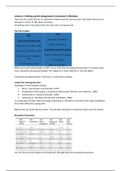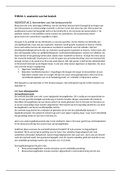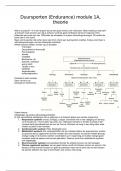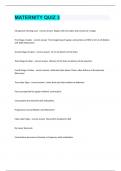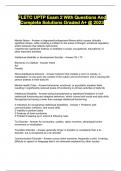Which of the following is not an example of bureaucratic functioning in organizations?
- Advertising and marketing brochures
Paperwork and record-keeping, hierarchical organizational structure, policies, rules, and procedures, are
all bureaucratic techniques by which the behaviour of the workforce is controlled by indirect, impersonal
means rather than face-to-face. Advertising and marketing brochures give information about the
organization and its products to external parties, they are not used to control the workforce in the same
way that bureaucratic techniques would. Page reference: 32
Which of the following best describes the control and management of workers performed on a personal,
face-to-face basis?
- Direct control
Where the number of people to be managed is small enough for it to be done personally and face-to-
face, this is known as direct control. The span of control is the number of people that any one manager
controls directly. Impersonal and indirect control are the types of bureaucratic control that are carried
out through delegation, through rules and procedures, or through paperwork – they are not carried out
on a face-to-face basis. Page reference: 32
Which of the following best describes the reason for bureaucratic rules and procedures in organizations?
- They are designed to ensure that everyone across the organizational hierarchy is acting in the
same way.
Rules and procedures are aimed at standardizing behaviour across an organization, ensuring that all
managers will treat employees in the same way. This may well create jobs to implement the rules, but is
not a reason for them. The span of control is an issue of hierarchy and delegation rather than rules and
procedures. Rules and procedures are about controlling the organization effciently, and do not
necessarily come from a moral perspective (although some managers may well believe that there is a
moral duty to abide by rules!. Page reference: 42
Which of the following does not apply to bureaucratic records and paperwork?
Records and paperwork allow control over an organization to take place by storing information in a
standardized form that can be retrieved quickly. Such information can be used to exert surveillance over
individuals, with records and information about them being stored in means that are easily accessible.
Indeed, some organizations exist purely to process information and records about people, even whole
populations – such as government agencies, which process information about driving registrations or tax
and income. Whilst paperwork was originally stored on paper in a fling cabinet, it is now often stored in
computer databases, where the standardized information can be accessed even more quickly and in a
greater volume. Page reference: 45
Which of the following is not an aspect of Taylor's scientifc management?
Scientifc management is based around a division of labour, where individual tasks are analysed in detail
using a time and motion study, and where tasks are redesigned, the planning all done by management
with workers simply doing as they are directed. Scientifc management eliminates rather than uses craft
skills. Page reference: 74
Which of the following best describes Ford’s assembly line?
- It is more controlling than Taylorism because the moving assembly line controls the pace of
work.
The assembly gives an additional element of control to Taylorism in that the speed of work is dictated by
the machinery – by the speed of the line itself. Page reference: 82
Which of the following is a critique of rational work design put forward by Karl Marx?



